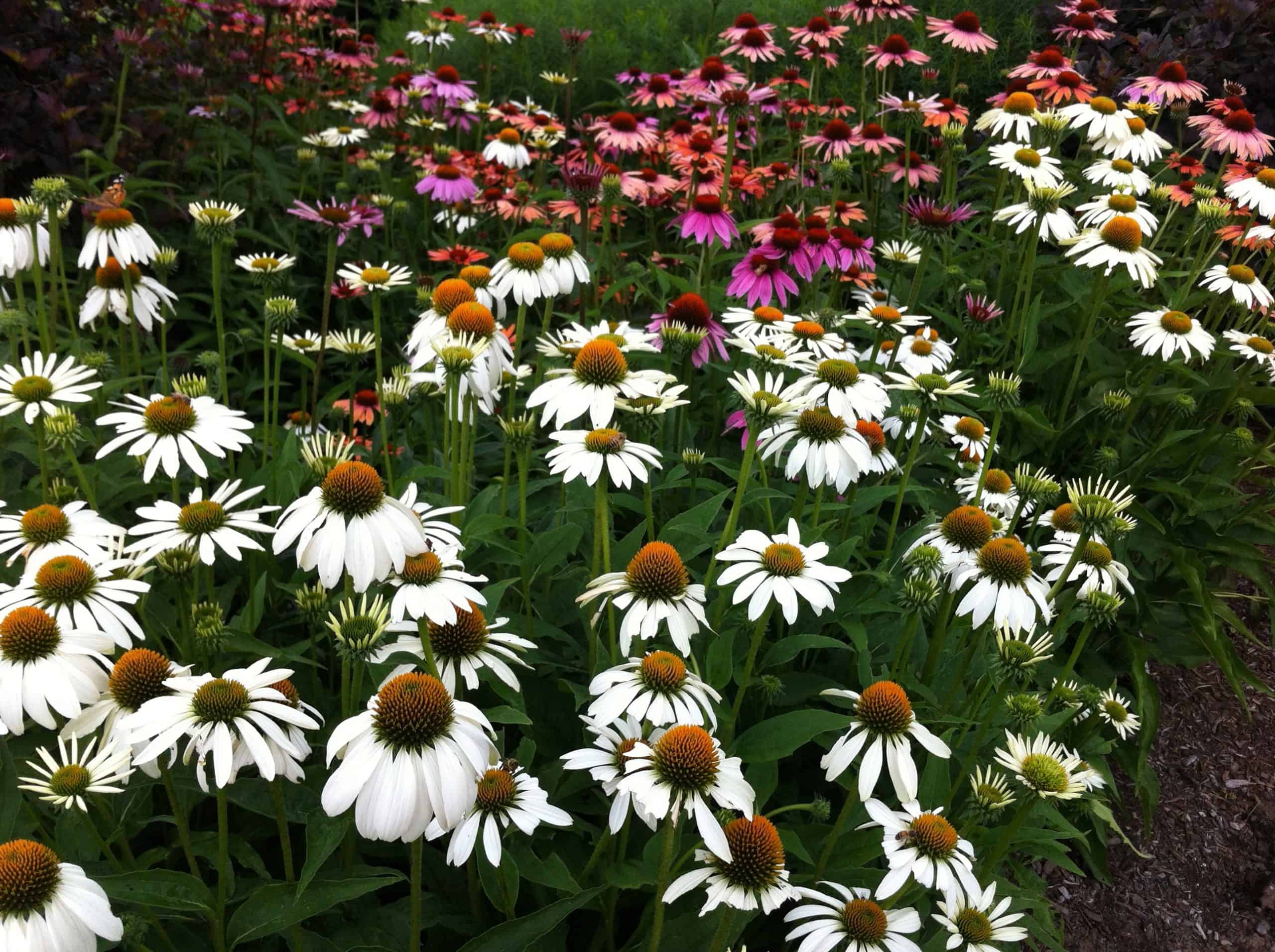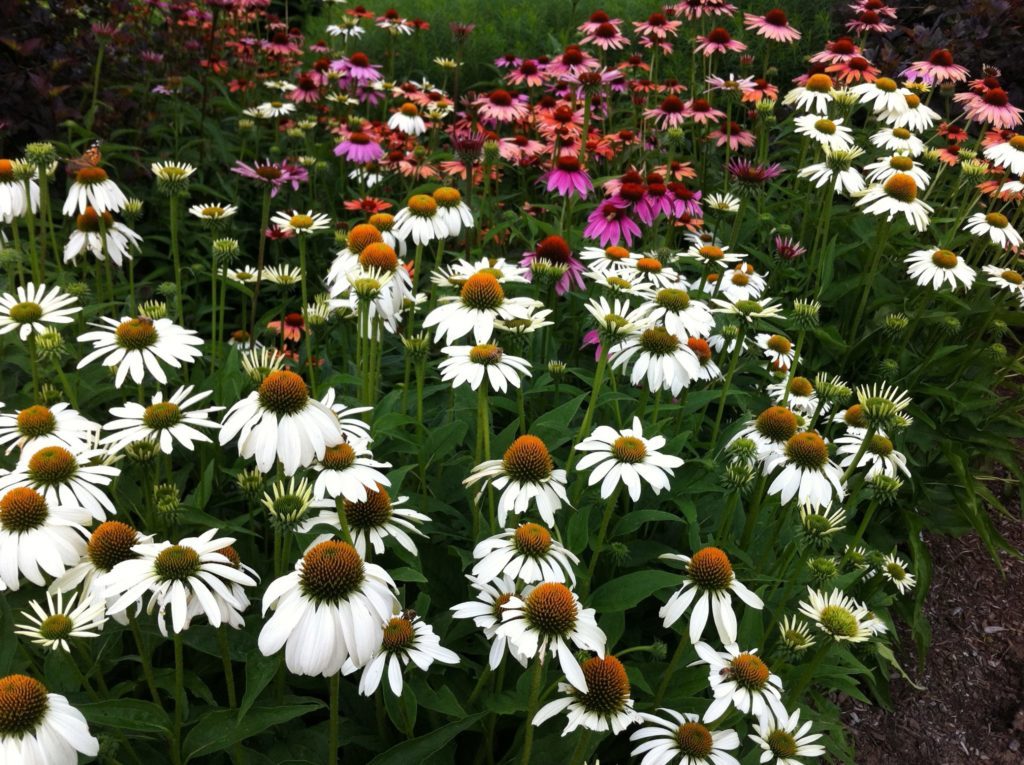Purple coneflowers (Echinacea purpurea) and their cultivars are exceedingly popular perennials. They’re easy to grow, relatively hardy, pest-free, drought-tolerant and provide a source of nectar and pollen for insects. (More on this last point later.) What’s not to like?

Purple coneflowers (Echinacea purpurea) caught the attention of plant breeders in the 90s, and they began increasing their colour range and flower form at a rapid rate, enabling them to bring many new choices to market quickly. As a result, the perennial’s colour range has been expanded beyond the dusky purple of the native species to white, yellow, lime green, pink, peach, orange and red. Flower forms have changed, too, as breeders worked to create heavily doubled blooms that look like giant pom-poms.
These new cultivars may include genes from other echinacea species, such as E. paradoxa, found in the southern U.S. Therefore, what may have been gained in colour range may be at the expense of hardiness. Also, some new introductions may be sterile, meaning they’re of little use to pollinators. Or, the blooms are so densely doubled that pollinators wouldn’t even be able to find their way to pollen, should there be any.
So, when it comes to shopping for a new echinacea, decide what’s a priority for you. Native species, or cultivars closely related to these species, will be more beneficial for pollinators and may be longer-lived and hardier than the fancier cultivars. However, if you want the latest and greatest to round out your landscape design, the newest echinaceas will delight you with their rich colours and intriguing flower shapes.
Mt. Cuba Center, a non-profit botanical garden in Delaware, has recently released the results of its two-year trial that evaluated echinacea cultivars and species on their ability to attract pollinators. (The cultivars they chose for the trial are classified as hardy to the mid-Atlantic region, which corresponds — very roughly — to Zones 6 and 7 in Canada.) This is the centre’s second study of the genus. Interestingly, ‘Pica Bella’ and white ‘Fragrant Angel’, cultivars of E. purpurea, were as appealing to pollinators as the straight species.
If you’re an echinacea enthusiast, you’ll find the 24-page report highly educational. It examines 75 cultivars and species from both horticultural and ecological perspectives. You’ll learn why some of the newer cultivars aren’t as long-lived as the species, describes what can be done about aster yellows and explains the pros and cons of volunteer seedlings. Gorgeous photos, too.
Margaret Roach of Away to Garden interviewed Sam Hoadley, manager of horticultural reseach, about the study’s results, and the transcript of her podcast sheds more light on these perennials, too.
Check for viburnum leaf beetle egg cases
Now may be a good time to check to see if any of your viburnums are harbouring the egg cases of leaf beetles, which can be devastating in summer. Judith Adam describes what to look for in “Pruning out viburnum leaf beetle egg cases.” There’s also a list of species that are less attractive to this pest.
Fear not the rose
If you’re under the impression that roses are prima donnas, The Garden Professors helps bust six common myths related to rose growing that might convince you to add a rose or two to your garden this year.
Inaugural virtual garden festival
This looks neat — a three-day virtual garden festival March 19 to 21 with more than 40 sessions on topics such as edible gardening, pollinators and plants, DIY landscaping, urban gardening, houseplants, and organic gardening. The speaker lineup for the inaugural Great Grow Along includes Amanda Thomsen, Doug Tallamy, Kelly Norris, Brie Arthur and Toronto’s own Darryl Cheng of House Plant Journal. Each session will include time for questions. The cost for the festival is $32.59 (US), which allows access to all the sessions.
Interactive bird poster
Once the weather warms, early morning bird chatter starts my day. It’s better than an alarm clock. An illustrated poster from Minnesota Conservation Volunteer lets you click on an individual bird to hear its song. My morning chorus is made up of goldfinches, cardinals and song sparrows.
Patience is a virtue …
… Especially if you’re eager for your seed orders to arrive. I’ve had a few messages in my inbox from various seed retailers, urging customers to be patient as they manage another busy spring coupled with the complications of slower than usual mail delivery. “After an extremely busy 2020 spring season, our projections for 2021 have been over and above expectations,” writes William Dam Seeds, located in Dundas, Ontario. “This year we received an entire year’s worth of orders in less than a month.”
Overall, this is a good thing for the industry, because it means people who embraced gardening for the first time last year during the pandemic are keeping at it. And more gardeners mean more choices and a viable industry, a boon for new and experienced gardeners alike.









